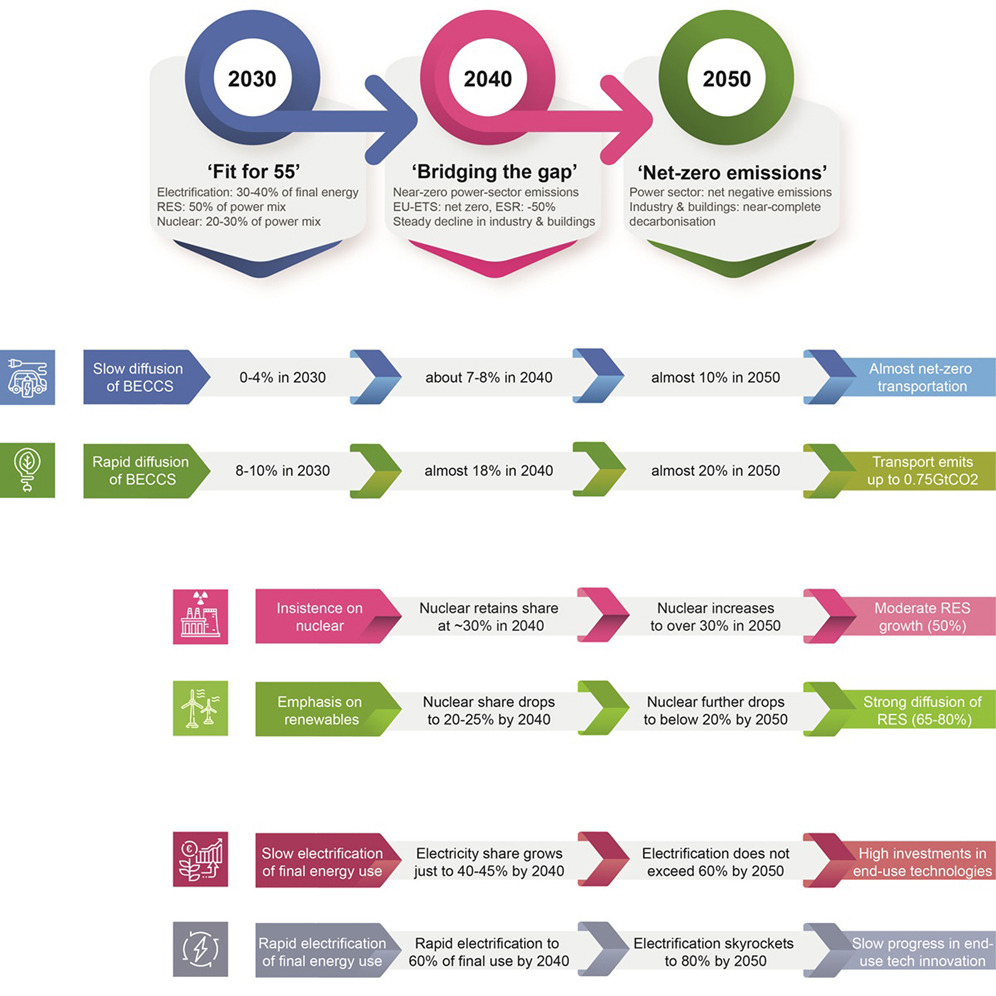Introduction
The European Union (EU) has recently adopted the “Fit for 55” policy package that aims to achieve 55% emissions cuts in 2030, compared with 1990. In response to this policy, this multi-model study uses five whole-system climate-economy models and two sectoral models to explore how the EU can keep the net-zero target within reach by mid-century, offering insights into intermediate milestones and implications at sectoral and national levels. Specifically, the study evaluates four EU pathways that conform to the “Fit for 55” targets in 2030 and achieve net-zero emissions in 2050, with different levels of contribution from non-CO2 and/or LULUCF emissions to mitigation.
The study uses an ensemble of five climate-economy models from different modelling paradigms and theories, including partial equilibrium models (GCAM, EU-TIMES), CGE models (GEMINI-E3, ICES-XPS), and a macroeconometric model (NEMESIS). Additionally, the study used two sectoral models that can represent the transport sector (ALADIN) as well as the buildings and industry sector (FORECAST) to explore more sectoral impacts.
The results of the study emphasise that the EU should phase out unabated coal power plants and fully decarbonise its power sector by 2040 in order to achieve its climate policy goals. However, the diverse modelling ensemble led to a variety of policy and technology pathways for other technologies or sectors. For instance, some models emphasised ramping up the deployment of renewable sources while others suggested to retain and even grow nuclear power in Europe. See the figure below for more of these trade-offs.
More details about the study and the modelling process can be found in the open-access publication from Boitier et al. (2023).
Policy Questions
What is the reduction of CO2 emissions from energy and industrial processes in different EU pathways to net zero?
Among all examined sectors, the energy-supply sector shows the strongest emissions reductions between 2020 and 2030, reaching a 40% emissions reduction on average for all different models (median value; interquartile range: 22% – 61%). Additionally, all models agree that the power sector should be fully decarbonised in order to achieve net-zero emissions in 2050. Modelling results converge less for other sectors, emphasising different priorities and policy options. However, all modelled pathways indicate that an economy-wide reduction of fossil fuels is needed to achieve the net-zero targets of the EU.
You can explore below the results in more detail for each different sector and scenario.
Please select a sector and a scenario to view the results.

The chart will present the total CO2 emissions from energy in
the EU across models until 2050.
Loading...
- NZE_Bench_H: Net-Zero Emissions Benchmark scenario with high contribution of non-CO2 and/or LULUCF emissions to mitigation
- NZE_Bench_M: Net-Zero Emissions Benchmark scenario with medium contribution of non-CO2 and/or LULUCF emissions to mitigation
- NZE_Bench_L: Net-Zero Emissions Benchmark scenario with low contribution of non-CO2 and/or LULUCF emissions to mitigation
- NZE_EUPol_Stand: The NZE EU Policy Standard scenario, in addition, implements the EU-level policy instruments as proposed in the 'Fit for 55' policy package regarding burden sharing between the EU-ETS and ESR sectors
- WWH21: Reference scenario
What is the level of Carbon Capture and Storage that is assumed by different NZE scenarios?
More content coming soon!
How do primary energy consumption and power generation in the EU change across different models and scenarios?
More content coming soon!



